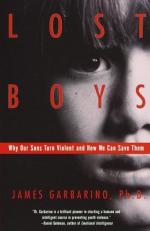
|
| Name: _________________________ | Period: ___________________ |
This test consists of 15 multiple choice questions and 5 short answer questions.
Multiple Choice Questions
1. What does Garbarino call the new social math?
(a) When children realize they have a more likely percentage of survival in a gang.
(b) When children realize they have a less likely percentage of survival than those in higher classes.
(c) When children realize they have a more likely percentage of survival joining a church group.
(d) When children realize they have a less likely percentage of survival in a gang.
2. Character education supports a set of core values, or ___________________.
(a) Landmarks of success.
(b) Social triggers.
(c) Pillars of character.
(d) Social anchors.
3. What is the first task, according to Garbarino's political agenda to stop youth violence?
(a) To reduce exposure to violent images.
(b) To reduce police brutality.
(c) To reduce abuse.
(d) To reduce exposure to alcohol and drugs.
4. Youths who participate in the drug economy or chronic theft have distorted __________________.
(a) Terminal thinking.
(b) Materialistic values.
(c) Concepts of self.
(d) Psychological images.
5. What is the term for those who are amoral in psychiatric terms?
(a) Psychopath.
(b) Criminal.
(c) Schizophrenic.
(d) Manic depressant.
6. According to General S.L.A. Marshall, resilience is not:
(a) Absolute.
(b) Futile.
(c) Necessary.
(d) Lasting.
7. Many extremely violent boys have experienced trauma to ___________________.
(a) Their souls.
(b) Their spirits.
(c) Their legs.
(d) Their brains.
8. These can help young boys develop a positive sense of self.
(a) Empathy and apathy.
(b) Love and kindness.
(c) Spirituality and love.
(d) Care and concern.
9. Trauma occurs when overwhelming ideas combine with ____________________.
(a) Overwhelming parental abuse.
(b) Overwhelming feelings.
(c) Overwhelming peer pressure.
(d) Overwhelming thoughts.
10. According to Garbarino's interview of third graders in Illinois, how many believed they could get a gun if needed?
(a) Three fourths.
(b) One in twenty.
(c) One third.
(d) One half.
11. What is amoral?
(a) Being conflicted by morality.
(b) Being confused by morality.
(c) Being too filled with morality.
(d) Being without any morality.
12. What is the term used to signify, among other things, the ability to read emotions of others?
(a) Emotional stability.
(b) Emotional ability.
(c) Emotional intelligence.
(d) Emotional response.
13. The monastery approach focuses on ____________________.
(a) Order and anger.
(b) Confrontation and dominance.
(c) Contemplation and reflection.
(d) Power assertion and structure.
14. Garbarino claims some boys seek out images of evil and become addicted to them as a way of responding to what?
(a) The anger they feel inside.
(b) The emptiness they feel inside.
(c) Social pressures to conform.
(d) The resentment they feel inside.
15. The third line of defense against violent teens are early intervention programs that deal with ___________________.
(a) Bullying issues.
(b) Alcohol issues.
(c) Drug issues.
(d) Attachment issues.
Short Answer Questions
1. What was "Early Warning, Timely Response" supposed to help with?
2. What are violent children learning about adults in their lives at early ages?
3. Learning about the destruction of human bodies is __________________.
4. How many teens in 1992 believed you could trust others?
5. Some children are more affected by this than others, according to psychologist Leonard Eron.
|
This section contains 489 words (approx. 2 pages at 300 words per page) |

|




